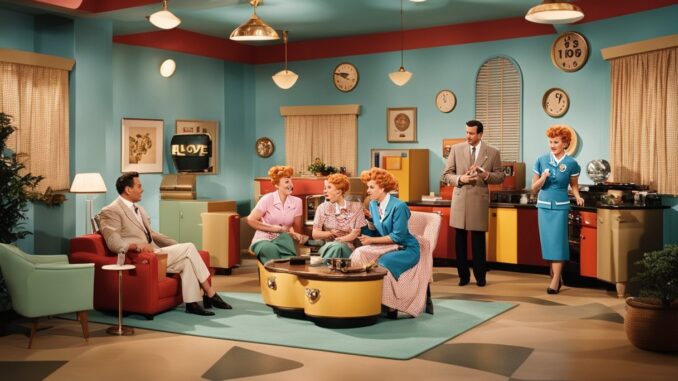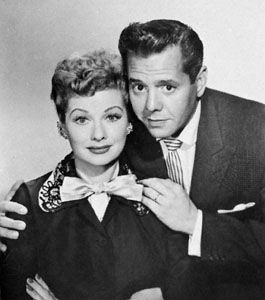
Few shows in television history have left an indelible mark like I Love Lucy. This groundbreaking sitcom didn’t just entertain – it revolutionized how stories were told on TV, setting the stage for generations of shows that followed. From innovative filming techniques to its progressive approach to humor and social issues, I Love Lucy wasn’t just a sitcom; it was a television movement. Let’s explore the many ways this iconic show has influenced the entertainment world.
The Cultural Revolution Sparked by I Love Lucy
When I Love Lucy premiered in 1951, it was nothing short of a cultural phenomenon. The series did more than captivate audiences; it addressed taboo topics, introduced new filming styles, and brought women into the spotlight in a way television had never done before.
The Unlikely Chemistry of Lucille Ball and Desi Arnaz

The show starred Lucille Ball and her real-life husband, Desi Arnaz, who had undeniable on-screen chemistry. Their dynamic was electric, but their differences – Lucille, a white American actress, and Desi, a Cuban bandleader – broke significant ground. This blend of cultures and personalities reflected real-world relationships and made the show more relatable to a diverse audience.
Breaking Racial and Cultural Barriers
The show challenged racial norms by presenting a biracial couple in a time when segregation was rampant in America. Desi Arnaz’s Cuban heritage was prominently featured, and his accent and culture were celebrated rather than hidden. This openness helped broaden society’s perspective on cultural differences and relationships, an idea far ahead of its time.
Innovative Filming Techniques That Changed Television
I Love Lucy pioneered numerous filming techniques that are still standard in TV production today. Under the guidance of Desi Arnaz and cinematographer Karl Freund, the show used a three-camera setup, something now common in sitcom production.
Multi-Camera Setup and Live Audience Impact
Unlike previous sitcoms, which were usually filmed with a single camera and dubbed laugh tracks, I Love Lucy used a three-camera setup in front of a live studio audience. This approach captured genuine reactions and made the comedy more engaging. This technique transformed the way television comedies were filmed and is still the backbone of multi-camera sitcoms today.
High-Quality Filming with a Cinematic Look
The use of high-quality film instead of lower-quality live kinescope recordings meant that I Love Lucy episodes could be preserved for reruns, introducing the concept of syndication. This approach allowed the show to reach a wider audience and changed the economics of television production by opening the door to continuous revenue from reruns.
Lucille Ball – A Comedic Powerhouse and Female Pioneer

Lucille Ball’s comedic genius set I Love Lucy apart from other shows. Her physical comedy, expressive face, and perfect timing made her an instant sensation. Ball’s portrayal of Lucy Ricardo turned her into one of the most beloved characters on television and an icon of female-driven comedy.
Pushing the Boundaries of Comedy for Women
In an era when women’s roles were largely limited to the home, Lucy Ricardo was different. She was ambitious, bold, and willing to defy societal norms. Whether scheming to get into her husband’s show or cooking up a hilarious disaster, Lucy represented an early model of independence and resilience that audiences, especially women, admired and aspired to emulate.
Lucille Ball as a Role Model for Female Entertainers
As one of the few female executives in Hollywood, Ball’s career inspired generations of women to pursue success in male-dominated fields. She became the first woman to run a major television production studio, Desilu Productions, which produced hit shows like Star Trek and Mission: Impossible.
The Power of Laughter and Universal Relatability
At the heart of I Love Lucy was its universal humor. The show’s comedy was timeless, built on relatable situations rather than shock or vulgarity, which is why it resonates even today.
Situational Comedy That Transcended Generations
Lucy’s outlandish schemes and antics were hilarious and highly relatable. She wanted to succeed, often failed spectacularly, and tried again – a simple yet universal concept. Episodes like the famous “Chocolate Factory” scene tapped into the struggles of everyday people, making the audience feel connected and understood.
How Physical Comedy Elevated the Show
Ball’s physical comedy was unmatched. Her willingness to throw herself into absurd situations – getting soaked in a vat of grapes or slipping on an assembly line of chocolates – brought out a level of dedication that few actors dared. This style influenced future comedians like Carol Burnett and Jim Carrey, who drew inspiration from her fearless approach to humor.
Tackling Real-Life Issues Through Comedy
I Love Lucy wasn’t afraid to address sensitive topics under the guise of comedy. From exploring marital issues to pregnancy, the show tackled real-life challenges in a light-hearted yet poignant way.
Normalizing Pregnancy on TV
When Lucille Ball became pregnant with her son, the show’s producers faced a dilemma. Pregnancy was rarely shown on TV due to conservative values of the time. However, I Love Lucy turned it into a plotline, humorously exploring Lucy’s experience as an expectant mother. This was groundbreaking, paving the way for more authentic representations of family life on television.
Humor as a Tool for Tackling Taboos
By blending humor with sensitive subjects, the show broke taboos and encouraged audiences to discuss topics like marriage, parenting, and gender roles. The show’s comedic lens provided a safe way for viewers to question social norms without controversy.
Setting the Standard for Syndication and Reruns
I Love Lucy was one of the first shows to air reruns, establishing a model for syndication that became a standard in television. This revolutionary concept allowed the show to continue reaching new audiences long after its original run, proving that great content can remain relevant across generations.
How Syndication Created Lasting Popularity
The decision to film the series at high quality allowed it to be shown repeatedly, creating a long-lasting connection with audiences. Even decades later, the show’s timeless humor and relatable stories keep it relevant.
Monetizing Television in New Ways
Through reruns and syndication, I Love Lucy established new financial models for television. The success of syndication not only boosted the show’s legacy but also opened up new revenue streams for the industry, setting a lucrative standard that remains vital in television production today.
The Influence of I Love Lucy on Modern Sitcoms
From Friends to The Big Bang Theory, the influence of I Love Lucy is seen in countless modern sitcoms. The show’s groundbreaking techniques, memorable characters, and fearless comedy paved the way for future television.
Pioneering the Format of the Modern Sitcom
The family-centric plot, episodic format, and multi-camera filming style established by I Love Lucy are now hallmarks of sitcoms worldwide. Shows that followed have consistently drawn from its format, demonstrating the timeless appeal of the show’s approach to storytelling.
Inspiring Female Comedians and Storytellers
Lucille Ball’s influence extends to comedians like Tina Fey, Amy Poehler, and Mindy Kaling, who credit her for opening doors for women in comedy. Her trailblazing career laid the foundation for women to succeed in leading, writing, and producing roles in television.
Conclusion: A Legacy That Continues to Shine
I Love Lucy remains a pillar of television history, celebrated for its wit, innovation, and cultural impact. Lucille Ball and Desi Arnaz’s vision forever changed the landscape of entertainment, crafting a legacy that future generations cherish. Today, it’s clear that I Love Lucy isn’t just a classic sitcom; it’s a monumental piece of television history that continues to inspire and entertain.
